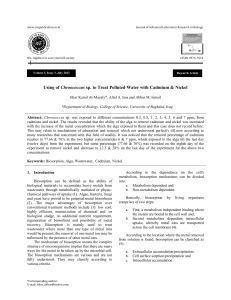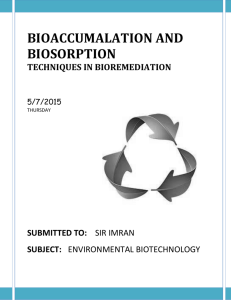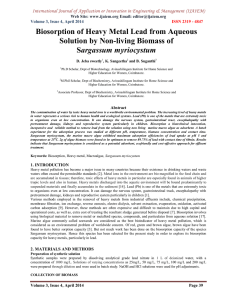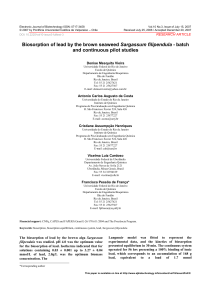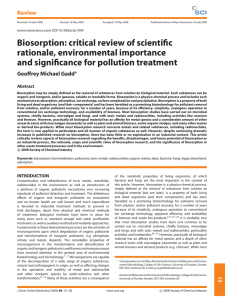chemical characterization of the biosorption of heavy metals
advertisement
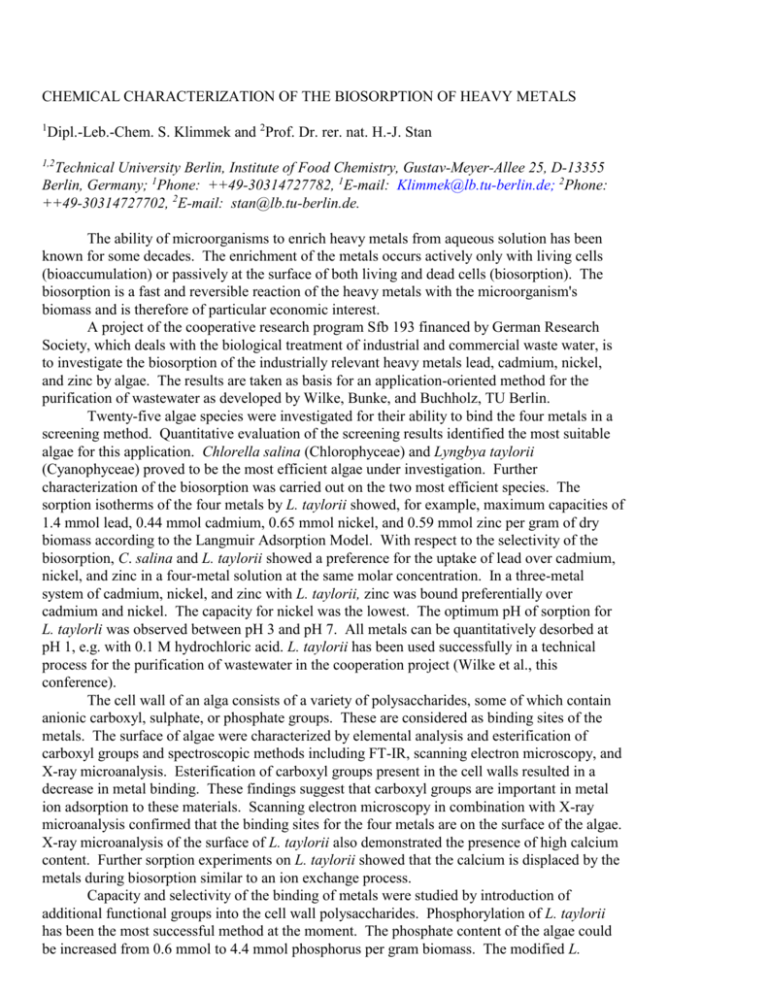
CHEMICAL CHARACTERIZATION OF THE BIOSORPTION OF HEAVY METALS 1 Dipl.-Leb.-Chem. S. Klimmek and 2Prof. Dr. rer. nat. H.-J. Stan 1,2 Technical University Berlin, Institute of Food Chemistry, Gustav-Meyer-Allee 25, D-13355 Berlin, Germany; 1Phone: ++49-30314727782, 1E-mail: Klimmek@lb.tu-berlin.de; 2Phone: ++49-30314727702, 2E-mail: stan@lb.tu-berlin.de. The ability of microorganisms to enrich heavy metals from aqueous solution has been known for some decades. The enrichment of the metals occurs actively only with living cells (bioaccumulation) or passively at the surface of both living and dead cells (biosorption). The biosorption is a fast and reversible reaction of the heavy metals with the microorganism's biomass and is therefore of particular economic interest. A project of the cooperative research program Sfb 193 financed by German Research Society, which deals with the biological treatment of industrial and commercial waste water, is to investigate the biosorption of the industrially relevant heavy metals lead, cadmium, nickel, and zinc by algae. The results are taken as basis for an application-oriented method for the purification of wastewater as developed by Wilke, Bunke, and Buchholz, TU Berlin. Twenty-five algae species were investigated for their ability to bind the four metals in a screening method. Quantitative evaluation of the screening results identified the most suitable algae for this application. Chlorella salina (Chlorophyceae) and Lyngbya taylorii (Cyanophyceae) proved to be the most efficient algae under investigation. Further characterization of the biosorption was carried out on the two most efficient species. The sorption isotherms of the four metals by L. taylorii showed, for example, maximum capacities of 1.4 mmol lead, 0.44 mmol cadmium, 0.65 mmol nickel, and 0.59 mmol zinc per gram of dry biomass according to the Langmuir Adsorption Model. With respect to the selectivity of the biosorption, C. salina and L. taylorii showed a preference for the uptake of lead over cadmium, nickel, and zinc in a four-metal solution at the same molar concentration. In a three-metal system of cadmium, nickel, and zinc with L. taylorii, zinc was bound preferentially over cadmium and nickel. The capacity for nickel was the lowest. The optimum pH of sorption for L. taylorli was observed between pH 3 and pH 7. All metals can be quantitatively desorbed at pH 1, e.g. with 0.1 M hydrochloric acid. L. taylorii has been used successfully in a technical process for the purification of wastewater in the cooperation project (Wilke et al., this conference). The cell wall of an alga consists of a variety of polysaccharides, some of which contain anionic carboxyl, sulphate, or phosphate groups. These are considered as binding sites of the metals. The surface of algae were characterized by elemental analysis and esterification of carboxyl groups and spectroscopic methods including FT-IR, scanning electron microscopy, and X-ray microanalysis. Esterification of carboxyl groups present in the cell walls resulted in a decrease in metal binding. These findings suggest that carboxyl groups are important in metal ion adsorption to these materials. Scanning electron microscopy in combination with X-ray microanalysis confirmed that the binding sites for the four metals are on the surface of the algae. X-ray microanalysis of the surface of L. taylorii also demonstrated the presence of high calcium content. Further sorption experiments on L. taylorii showed that the calcium is displaced by the metals during biosorption similar to an ion exchange process. Capacity and selectivity of the binding of metals were studied by introduction of additional functional groups into the cell wall polysaccharides. Phosphorylation of L. taylorii has been the most successful method at the moment. The phosphate content of the algae could be increased from 0.6 mmol to 4.4 mmol phosphorus per gram biomass. The modified L. taylorii shows very good biosorption properties. L. taylorii showed maximum capacities of 3.22 mmol lead, 2.52 mmol cadmium, 2.91 mmol nickel, and 2.70 mmol zinc per gram of dry biomass. The desorption of the metals from phosphorylated biomass is in turn more difficult in comparison with the untreated L. taylorii. Tests showed that the metals can be desorbed with 3 M hydrochloric acid. Biosorption by algae thus demonstrated itself to be an useful alternative to conventional systems for the removal of toxic metals from wastewater. Key words: biosorption, algae, cadmium, lead, nickel zinc






